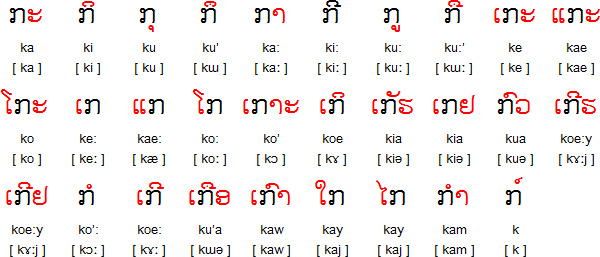After the unification of the Lao principalities (meuang) in the 14th century, the Lan Xang monarchs commissioned their scholars to create a new script to write the Lao language. The scholars probably modelled the alphabet on the the Old Khmer script, which was itself based on Mon scripts.
Lao, a Tai-Kadai language spoken by approximately 15 million people in Laos and Thailand. It is closely related to Thai and speakers of Lao are able to understand spoken Thai without too many difficulties. Thai speakers find it more difficult to understand Lao due to lack of exposure to the language. The language family is also known as Kradai, Kra-Dai, Daic or Kadai.
Also used to write: Tai Dam, Lave, Eastern Bru, Western Bru, Mong Njua, Iu Mien, Jeh, Kuy, Kataang, Lü, Khmu, Western Katu, Lamet, Hmong Daw, Ngeq, Pacoh, Phunoi, Upper Ta'oih and Lower Ta'oih
Source: http://scriptsource.org/scr/Laoo
Consonants are divided into three classes which help to determine the tone of a syllable (indicated by the numbers below). The sounds represented by some consonants change when they are used at the end of a syllable (indicated by the letters on the right of the slash below). The consonants can all be used at the beginning of a syllable but only some can be used at the end of a syllable.

The consonants in the final row are compounds and conjuncts used as alternatives to the basic consonants.


| Open syllables | Closed syllables * | ||||
| unmarked | short vowel | long vowel | |||
| Class 1 | low | mid | high falling | high | low falling |
| Class 2 | low rising | mid | low falling | high | low falling |
| Class 3 | high | mid | high falling | mid | high falling |
* Closed syllables are those ending with p, t or k

Transliteration
Manut thuk khôn kœ̄t māmīkẏat sâk sī,
sitthi, sēlī phôp læ khwôm smœ̄ phôp
thàw thẏam kân. Thuk thuk khôn mīhēt phôn
læ khwômkhit khwôm hian swàn tôw khɔ̄̄ṅ
phai khɔ̄ṅ mân, tǣ̀vồ manut thuk
thuk khôn khwan paphʉt tàṁ kân khʉ̄ kân
kâp pianốy nɔ̄́ṅ kân.
All human beings are born free and equal in dignity and rights. They are endowed with reason
and conscience and should act towards one another in a spirit of brotherhood.
(Article 1 of the Universal Declaration of Human Rights)
Tower of Babel in Lao | Useful phrases in Lao
![]() Lao language learning materials
Lao language learning materials
Information about Laos and the Laotian language
http://www.global.lao.net
http://en.wikipedia.org/wiki/Lao_language
Online Lao lessons and other useful resources
http://www.seasite.niu.edu/lao/LaoLanguage/Lao_language_fp.htm
http://www.laosoftware.com
Thai-Isan-Lao Phrasebook
http://www.phrasebook.thai-isan-lao.com
Free Lao fonts
http://www.wazu.jp/gallery/Fonts_Lao.html
http://www.laoscript.net/downloads/
http://www.global.lao.net/lswin
http://scriptsource.org/scr/Laoo
Virtual Lao Keyboard
http://mog.software.free.fr/Lao/
Online Lao news and radio
http://www.rfa.org/lao/
Ahom, Dehong Dai, Kam, Lanna, Lao, Lue, Shan, Tai Dam, Thai, Zhuang
Ahom, Balinese, Batak, Bengali, Brahmi, Buhid, Burmese, Chakma, Cham, Dehong Dai, Devanagari, Dhives Akuru, Ethiopic, Evēla Akuru, Gondi, Grantha, Gujarati, Gupta, Gurmukhi (Punjabi), Hanuno'o, Hmong, Javanese, Kannada, Kharosthi, Khmer, Lanna, Lao, Lepcha, Limbu, Lontara/Makasar, Malayalam, Manpuri, Modi, New Tai Lue, Oriya, Pallava, Phags-pa, Ranjana, Redjang, Shan, Sharda, Siddham, Sindhi, Sinhala, Sorang Sompeng, Sourashtra, Soyombo, Sundanese, Syloti Nagri, Tagalog, Tagbanwa, Takri, Tamil, Telugu, Thai, Tibetan, Tocharian, Varang Kshiti